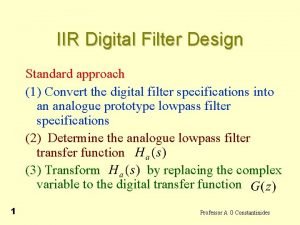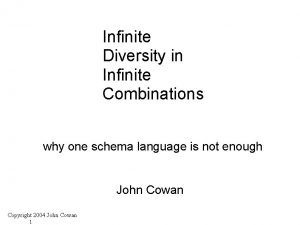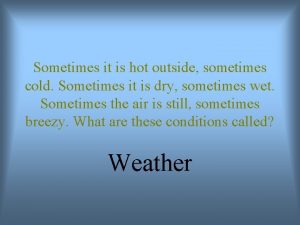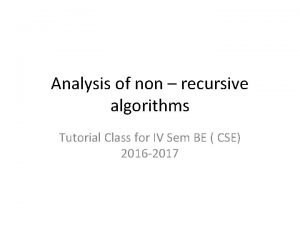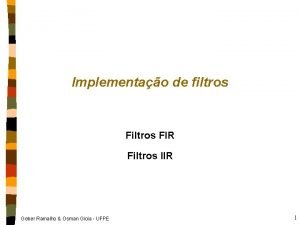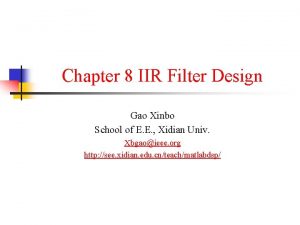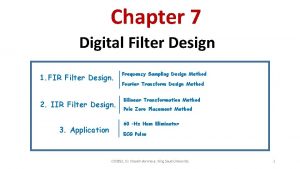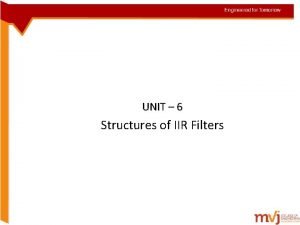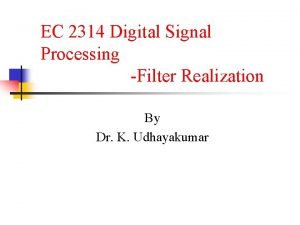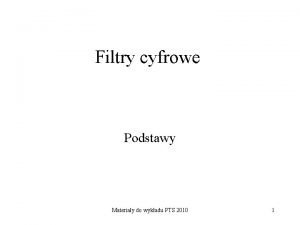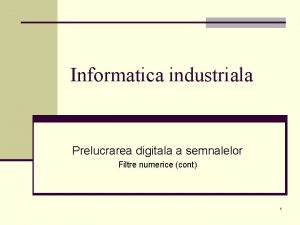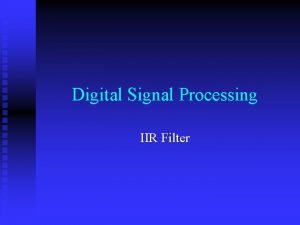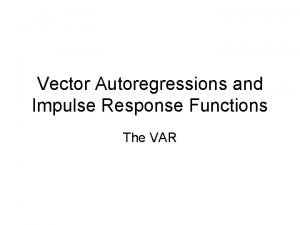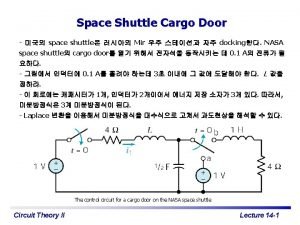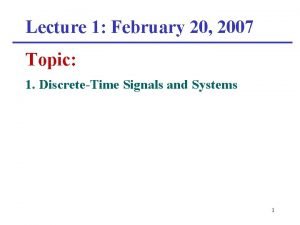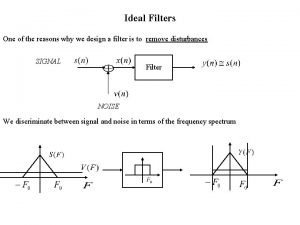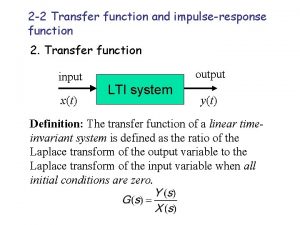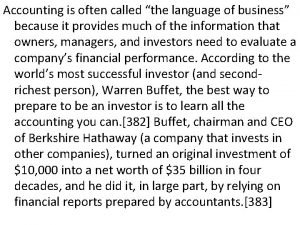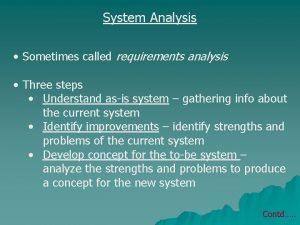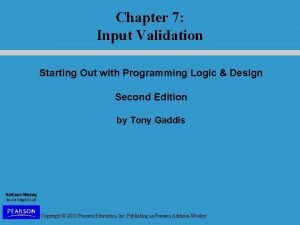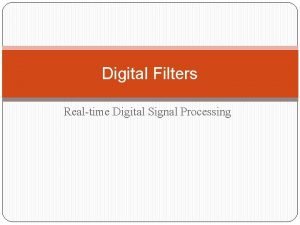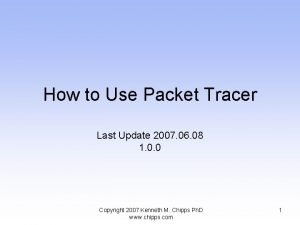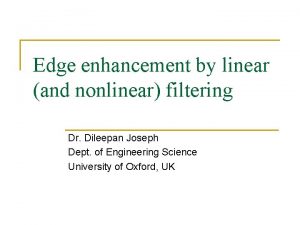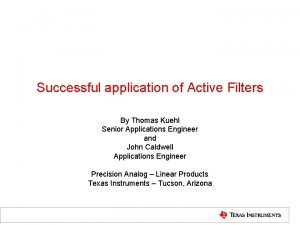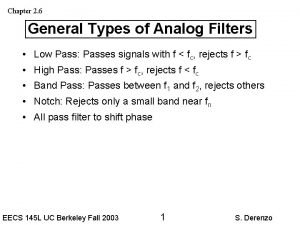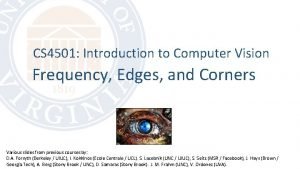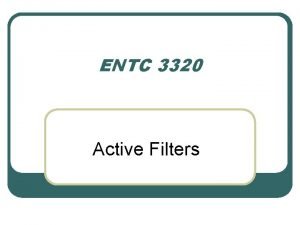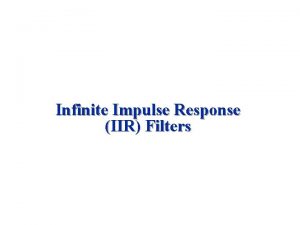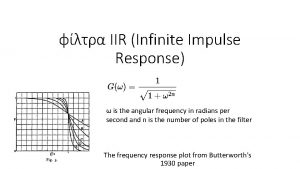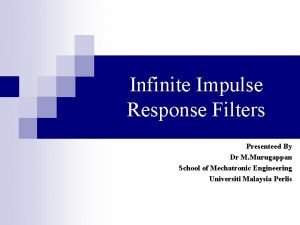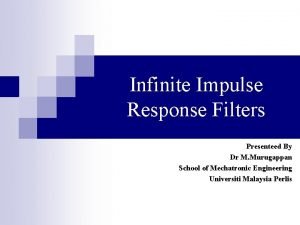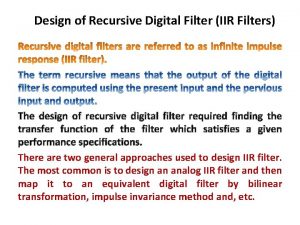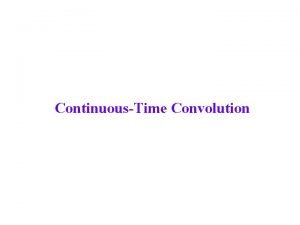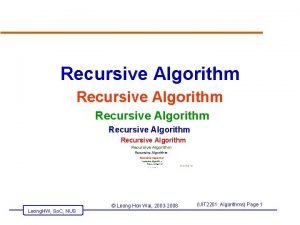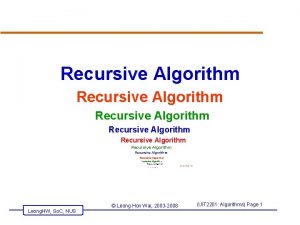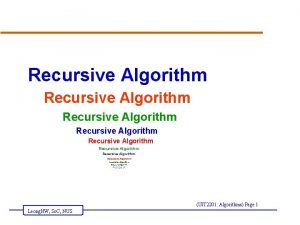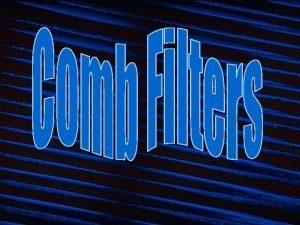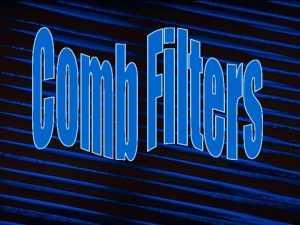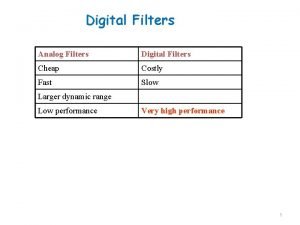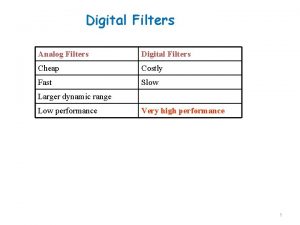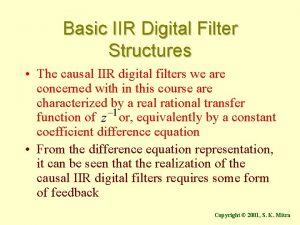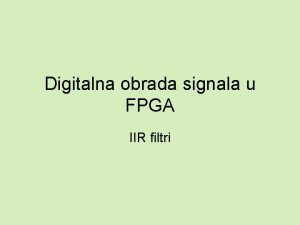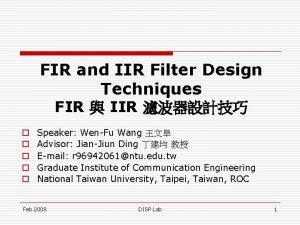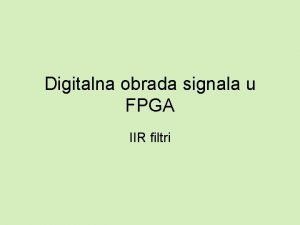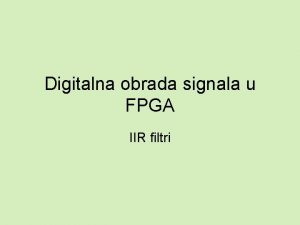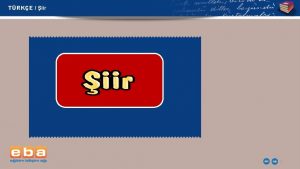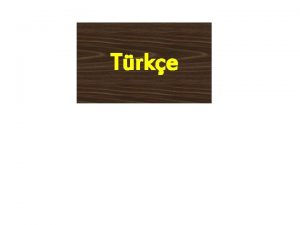Infinite Impulse Response IIR Filters Sometimes called recursive

![IIR Filter Code public static double[] convolution(double[] signal, double[] b, double[] a) { double[] IIR Filter Code public static double[] convolution(double[] signal, double[] b, double[] a) { double[]](https://slidetodoc.com/presentation_image_h2/6b19b2ea15085efbb21e7f9fe1d00aba/image-2.jpg)





















![The z-transform Z{x[n]} = • Z-transform is the discrete cousin to the Laplace Transform The z-transform Z{x[n]} = • Z-transform is the discrete cousin to the Laplace Transform](https://slidetodoc.com/presentation_image_h2/6b19b2ea15085efbb21e7f9fe1d00aba/image-24.jpg)








![Transfer Function Z{x[n]} = 1. 2. 3. 4. 5. 6. 7. A polynomial equation Transfer Function Z{x[n]} = 1. 2. 3. 4. 5. 6. 7. A polynomial equation](https://slidetodoc.com/presentation_image_h2/6b19b2ea15085efbb21e7f9fe1d00aba/image-33.jpg)










- Slides: 43

Infinite Impulse Response (IIR) Filters Sometimes called recursive filters • Uses both the input signal and previous filtered values y[n] = b 0 x[n] + b 1 x[n-1] + b 2 x[n-2] + … + a 1 y[n-1] + a 2 y[n-2] + a 3 y[n-3] + … • The bk coefficients comprise the FIR part; filtering the input signal • The ak coefficients comprise the IIR part; additional filtering using previously filtered values • This concept has overlap with neural networks, a popular algorithm that statistically “learns”
![IIR Filter Code public static double convolutiondouble signal double b double a double IIR Filter Code public static double[] convolution(double[] signal, double[] b, double[] a) { double[]](https://slidetodoc.com/presentation_image_h2/6b19b2ea15085efbb21e7f9fe1d00aba/image-2.jpg)
IIR Filter Code public static double[] convolution(double[] signal, double[] b, double[] a) { double[] y = new double[signal. length + b. length - 1]; for (int i = 0; i < signal. length; i ++) { for (int j = 0; j < b. length; j++) { if (i-j>=0) y[i] += b[j]*signal[i - j]; } if (a!=null) { for (int j = 1; j < a. length; j ++) { if (i-j>=0) y[i] -= a[j] * y[i - j]; } } } return y; }

Characteristics of Recursive Filters • Advantages – Powerful filtering with very few parameters – Execute very fast • Example 1: b 0 =. 15 and a 1 =. 85 • Example 1: b 0 = 0. 93 b 1 = -0. 93 a 1 = 0. 86 1. 0 0. 0 Input Signal Example 1 output Example 2 output

Low and High Pass Recursive Filter • Low Pass: b 0 = 1 -x, a 1 = x • High Pass: b 0 = (1+x)/2, b 1 = -(1+x)/x, a 1 = x • 0≤x≤ 1, which controls the low and high pass boundaries

Understanding Digital Signal Processing, Third Edition, Richard Lyons (0 -13 -261480 -4) © Pearson Education, 2011.

Understanding Digital Signal Processing, Third Edition, Richard Lyons (0 -13 -261480 -4) © Pearson Education, 2011.

IIR Disadvantages float x = 1 for (int i=0; i<N; i++) { float a=Math. random(); float b=Math. random(); x = x + a; x = x + b; x = x - a; x = x - b; } Do you see the flaws in the above program? Error • Can be unstable: yn = xn + yn-1 //running sum • Additive errors propagate (round off drift) • Possible non-linear group delay Loops

IIR Moving Average Filter Two additions per point no matter the filter length • Illustration (Sum of seven previous samples) y[50] = x[47]+x[48]+x[49]+x[50]+x[51]+x[52]+x[53] y[51] = x[48]+x[49]+x[50]+x[51]+x[52]+x[53]+x[54] = y[50] + x[54] – x[47] • Example: {1, 2, 3, 4, 5, 4, 3, 2, 1, 2, 3, 4, 5}; M = 4 – Starting filtered values: {¼ , ¾, 1 ½, 2 ½, … } – Next value: y 4 = 2 ½ + (5 – 1)/4 = 3 ½ • Filter of degree (length) M – Centered Version: yn = yn-1 + xn+(M-1)/2 - xn-(M-1)/2 – 1 – Non Centered Version: yn = yn-1 + xn/M –xn-M/M Note: Integers work best with this approach to avoid round off drift

Transforms Some problems are difficult (or impossible) to solve directly • Procedure – Transform the problem into a different domain – Execute a simpler algorithm in the transformed space – Transform back to get the solution • DSP Example: We need a well-defined way to determine IIR filter coefficients that result in a filter that performs properly • Image Processing: Mapping a three dimensional image into two dimension

Laplace Transform Works with continuous functions • The Fourier domain is a one dimensional space; each point represents a sinusoid of a particular frequency . Fourier Domain Negative frequency sinusoid Positive frequency sinusoid • The Laplace domain (SDomain) is a two dimensional Laplace Domain space of complex numbers; Positive frequency each point represents sinusoid that amplifies sinusoids of a particular at a positive rate Real axis frequency that either amplifies with higher y-axis values or degrades with lower y-axis Positive frequency sinusoid Imaginary that exponentially decay values axis (attenuates)

The S-Domain 1. Each S-Domain point models a basis function 2. The top half is a mirror image of the bottom Imag axis Real axis Note: The waveforms are counterintuitive since filters convolute from the current time backward. Attenuating waves, actually produces unstable filters

Laplace Transform Example The Fourier transform is the Laplace Transform when σ=0

Laplace Transform A technique for solving differential equations • Consider a process whose characteristics change over time • Some function governs the changing behavior of the process • We observe the process as a signal measured at points of time • We want to predict the outputs, when the input system interacts with a filtering system process. • We can model this problem with a differential equation, where time is the independent variable: a 1 y’’’(t) + a 2 y’’(t) + a 3 y’(t) = b 1 x’(t) +b 2 x(t)

Laplace Transform Definition dt • s is a complex number (σ+jω) where σ controls the degree of exponential decay and ω controls the frequency of the basis function • e-st = e-(σ+jω)t = e-jωt / eσt • The denominator controls the decay rate • The numerator controls the frequency • The integral starts if we are not interested in negative time (time past)

Impact of σ, ω values on the resulting basis function Assuming σ is negative Understanding Digital Signal Processing, Third Edition, Richard Lyons (0 -13 -261480 -4) © Pearson Education, 2011.

Poles and Zeroes dt • The integrations causes S-plane some points to: – Evaluate to 0 (these are zeroes) – Evaluate to ∞ (these are poles) • Pole and zero points determine IIR filter coefficients • Note: Designing a filter comes down to picking the pole and zero points on the S-plane

An S-domain Plot Note: The third dimension is the magnitude of ∫f(t)e-stdt at s = (σ+jω) Note The poles are the peaks The zeroes are the valleys

Understanding Digital Signal Processing, Third Edition, Richard Lyons (0 -13 -261480 -4) © Pearson Education, 2011.

Understanding Digital Signal Processing, Third Edition, Richard Lyons (0 -13 -261480 -4) © Pearson Education, 2011.

Time domain impulse response Understanding Digital Signal Processing, Third Edition, Richard Lyons (0 -13 -261480 -4) © Pearson Education, 2011.

Attenuating impulse response Amplifying impulse response Understanding Digital Signal Processing, Third Edition, Richard Lyons (0 -13 -261480 -4) © Pearson Education, 2011.

The Low Pass Filter Illustration Transform the rectangular time domain pulse into the frequency domain and Into the s-domain

S-domain for a notch filter Notation x = pole ○ = zero Fourier frequencies are the points where the real value is zero
![The ztransform Zxn Ztransform is the discrete cousin to the Laplace Transform The z-transform Z{x[n]} = • Z-transform is the discrete cousin to the Laplace Transform](https://slidetodoc.com/presentation_image_h2/6b19b2ea15085efbb21e7f9fe1d00aba/image-24.jpg)
The z-transform Z{x[n]} = • Z-transform is the discrete cousin to the Laplace Transform • Laplace Transform (s = σ+jω) – – Extends the Fourier Transform, uses integrals and continuous functions s = e-(σ+jω)t becomes the Fourier transform when ω = 0 Fourier points fall along the imaginary axis S-domain stable region is on the negative half of the domain • Z-Transform (z = re-2πk/ts) – – Extends the Discrete Fourier Transform, uses sums and discrete samples z = e-j 2πk/ts becomes the Discrete Fourier Transform (ts=sample size) Four transform points fall along the unit circle Z-domain stable domain are those within the unit circle

Compare S-plane to Z-plane (cont. ) • Filter design S: analog filters; Z: IIR filters • Equations S: differential equations, Z: difference equations • Filter Points S: rectangular along i axis, Z: polar around unit circle • Frequencies S: -∞ to ∞ (frequency line). Z: 0 to 2 π (frequency circle) • Plots S and Z: Upper and lower half are mirror images Note: the Lines to left of s-plane correspond to circles within the unit circle in the z-plane Positive frequencies Negative frequencies Looking down vertically from the top of the domain

Understanding Digital Signal Processing, Third Edition, Richard Lyons (0 -13 -261480 -4) © Pearson Education, 2011.

Understanding Digital Signal Processing, Third Edition, Richard Lyons (0 -13 -261480 -4) © Pearson Education, 2011.

Analog Filter Example Sallen-Key Filters on a circle of 1/RC radius A = amplification R= resistance C = capacitance σ=(A-3)/2 RC; ω=±(A 2+6 A-5)½/2 RC

Butter. Worth Filters Butter. Worth poles are equally spaced around the left side of a circle

Example Low Pass Filters • Butterworth poles are equally spaced on a circle • Chebshev poles are equally spaced on an ellipse • Elliptic poles are on an ellipse; zeroes added to the stopband north and south of the poles

There are tables of pole/zero points and their effects x x x x Examples x x x r φ Poles a 1 a 2 0. 8 0. 75 0. 58± 0. 54 j 1. 17 -1. 64 0. 8 1. 0 0. 43± 0. 67 j 0. 86 -0. 64 0. 8 1. 25 0. 25± 0. 76 j 0. 50 -0. 64 0. 8 1. 5 0. 056± 0. 78 j 0. 11 -0. 64 x Freq Bandwth r φ Poles F 1 300 250 0. 95 0. 12 0. 963± 0. 116 j F 2 2200 250 0. 95 0. 86 0. 619± 0. 719 j F 3 3000 250 0. 95 1. 17 0. 370± 0. 874 j

Pole Placement • Poles characterized by: – Amplitude: height of the resonance – Frequency: placement in the spectrum – Bandwidth: Sharpness of the pole • Place pole at reiφ – Amplitude and bandwidth shrink as r approaches the origin 3 -db down (half power) estimate = -2 ln(r) or 2(1 -r)/r½ – ω controls the resonant frequency v When ω ≠ 0, IIR coefficients will be complex numbers v IIR coefficients real if there are conjugate pairs (reiφ, re-iφ) v If r < 0. 5, the relationship between φ and frequency breaks down because the pole “skirts” cause results to be less precise
![Transfer Function Zxn 1 2 3 4 5 6 7 A polynomial equation Transfer Function Z{x[n]} = 1. 2. 3. 4. 5. 6. 7. A polynomial equation](https://slidetodoc.com/presentation_image_h2/6b19b2ea15085efbb21e7f9fe1d00aba/image-33.jpg)
Transfer Function Z{x[n]} = 1. 2. 3. 4. 5. 6. 7. A polynomial equation that defines filter coefficients for particular Z, S domain setting IIR Definition: yn = b 0 xn + b 1 xn-1 +…+ b. Mxn-M + a 1 yn-1 +…+ a. Nyn-N Z transform both sides: Yz=Z{b 0 xn+b 1 xn-1+…+b. Mxn-M+a 1 yn-1+…+a. Nyn-N} Linearity Property: Yz = Z{b 0 xn}+Z{b 1 xn-1}+…+Z{b. Mxn-M}+Z{a 1 yn-1}+…+Z{a. Nyn-N} Time delay property (Z{xn-k} = xzz-k) Yz = b 0 Xz + b 1 Xzz-1 +…+bn-MXzz-M + a 1 Yzz-1+…+a. NYzz-N Gather Terms Yz - a 1 Yzz-1 -…- a. NYzz-N = b 0 Xz + b 1 Xzz-1 +…+ bn-MXz-M Yz(1 - a 1 z-1 -…- a. Nz-N ) = Xz(b 0 + b 1 z-1 +…+ bn-Mz-M) Divide to get transfer function Yz/Xz= Hz= (b 0 + b 1 z-1 +…+ bn-Mz-M)/(1 - a 1 z-1 -…- a. Nz-N ) Yz = Xz (Yz/Xz) = Xz (Hz) // Hz is the transform function for the filter Perform Inverse Z transform: y[n] = x[n] * filter[n] // where * is convolution Because Z domain multiplication is time domain convolution Starting with the IIR definition, derive Z-Transform Transfer Function

Understanding Digital Signal Processing, Third Edition, Richard Lyons (0 -13 -261480 -4) © Pearson Education, 2011.

Transfer Function Example • Suppose – b 0=0. 389, b 1=-1. 558, b 2=2. 338, b 3=-1. 558, b 4=0. 389 – a 1=2. 161, a 2=-2. 033, a 3=0. 878, a 4=-0. 161 • Transfer Function H[z] = 0. 389 - 1. 558 z-1+2. 338 z-2 -1. 558 z-3+0. 389 z-4 / (1 -2. 161 z-1 + 2. 033 z-2 -0. 878 z-3+0. 161 z-4) = 0. 389 z 4 - 1. 558 z 3+2. 338 z 2 -1. 558 z 1+0. 389 / (z 4 -2. 161 z 3 + 2. 033 z 2 -0. 878 z 1+0. 161) • Find the roots = (z-z 1)(z-z 2)(z-z 3)(z-z 4) / (z-p 1)(z-p 2)(z-p 3)(z-p 4) Note: The bottom form tells us where the zeroes and poles are

Understanding Digital Signal Processing, Third Edition, Richard Lyons (0 -13 -261480 -4) © Pearson Education, 2011.

Z 1 = 1. 00 ei(π/4), Z 2 = 1. 00 ei(-π/4) P 1=0. 9 ei(π/4), P 2=0. 9 ei(-π/4) Notch Filter Z 1=0. 7071+0. 7071 i Z 2=0. 7071 -0. 7071 i P 1=0. 6364+0. 6364 i P 2=0. 6364 -0. 6364 i 1. 2. 3. 4. Convert to rectangular form Multiply the complex polynomials Collect terms Use the coefficients for the filter Note: Compare to the s-plane example

Second-order low pass IIR filter examples Understanding Digital Signal Processing, Third Edition, Richard Lyons (0 -13 -261480 -4) © Pearson Education, 2011.

Understanding Digital Signal Processing, Third Edition, Richard Lyons (0 -13 -261480 -4) © Pearson Education, 2011.

Understanding Digital Signal Processing, Third Edition, Richard Lyons (0 -13 -261480 -4) © Pearson Education, 2011.

Linear filters can be combined into parallel or serial systems Understanding Digital Signal Processing, Third Edition, Richard Lyons (0 -13 -261480 -4) © Pearson Education, 2011.

Note: It’s easier to design multiple two tap systems than a larger multiple tap system Understanding Digital Signal Processing, Third Edition, Richard Lyons (0 -13 -261480 -4) © Pearson Education, 2011.

Original Gain: (b 0+b 1)/(1 - a 1) = 0. 22 + 0. 25 / (1 -0. 87) = 3. 614 Do normalize gain, divide coefficients by 3. 64 Understanding Digital Signal Processing, Third Edition, Richard Lyons (0 -13 -261480 -4) © Pearson Education, 2011.
 Spectral transformation of iir filters
Spectral transformation of iir filters Impulse invariant method iir filter design
Impulse invariant method iir filter design Infinite diversity in infinite combinations
Infinite diversity in infinite combinations Sometimes sweet sometimes sour
Sometimes sweet sometimes sour Sometimes cold sometimes hot
Sometimes cold sometimes hot Sometimes you win some sometimes you lose some
Sometimes you win some sometimes you lose some God when you choose to leave mountains unmovable
God when you choose to leave mountains unmovable Analysis of non recursive algorithm
Analysis of non recursive algorithm Geber
Geber Iir filter design matlab
Iir filter design matlab Difference between iir and fir filter
Difference between iir and fir filter Structure of iir filter
Structure of iir filter Digital signal processing
Digital signal processing Projektowanie filtrów fir
Projektowanie filtrów fir Informatica iir
Informatica iir Iir filter design by approximation of derivatives
Iir filter design by approximation of derivatives Var model
Var model Unit step function convolution
Unit step function convolution Impulse response of lti system examples
Impulse response of lti system examples Finite impulse response
Finite impulse response Impulse response and transfer function
Impulse response and transfer function Why is accounting considered the language of business
Why is accounting considered the language of business Detailed analysis sometimes is called
Detailed analysis sometimes is called Plain, unformatted text is sometimes called ascii text.
Plain, unformatted text is sometimes called ascii text. Leap locomotor movement
Leap locomotor movement Sometimes called jbod
Sometimes called jbod Reading an empty input is an example of unobvious errors.
Reading an empty input is an example of unobvious errors. Natural and forced response
Natural and forced response What is natural response
What is natural response A subsequent
A subsequent Wet etch clean filters
Wet etch clean filters Digital image processing
Digital image processing Event list filters packet tracer
Event list filters packet tracer Joint legacy viewer website
Joint legacy viewer website Difference between linear and nonlinear spatial filters
Difference between linear and nonlinear spatial filters Application of active filters
Application of active filters Perceptual filters
Perceptual filters Our personal filters assumptions
Our personal filters assumptions Types of analog filters
Types of analog filters Filters in weka
Filters in weka Authentication filters in mvc 5
Authentication filters in mvc 5 Skimage.filters.gaussian
Skimage.filters.gaussian Advantage of active filter
Advantage of active filter Custom air filters
Custom air filters
